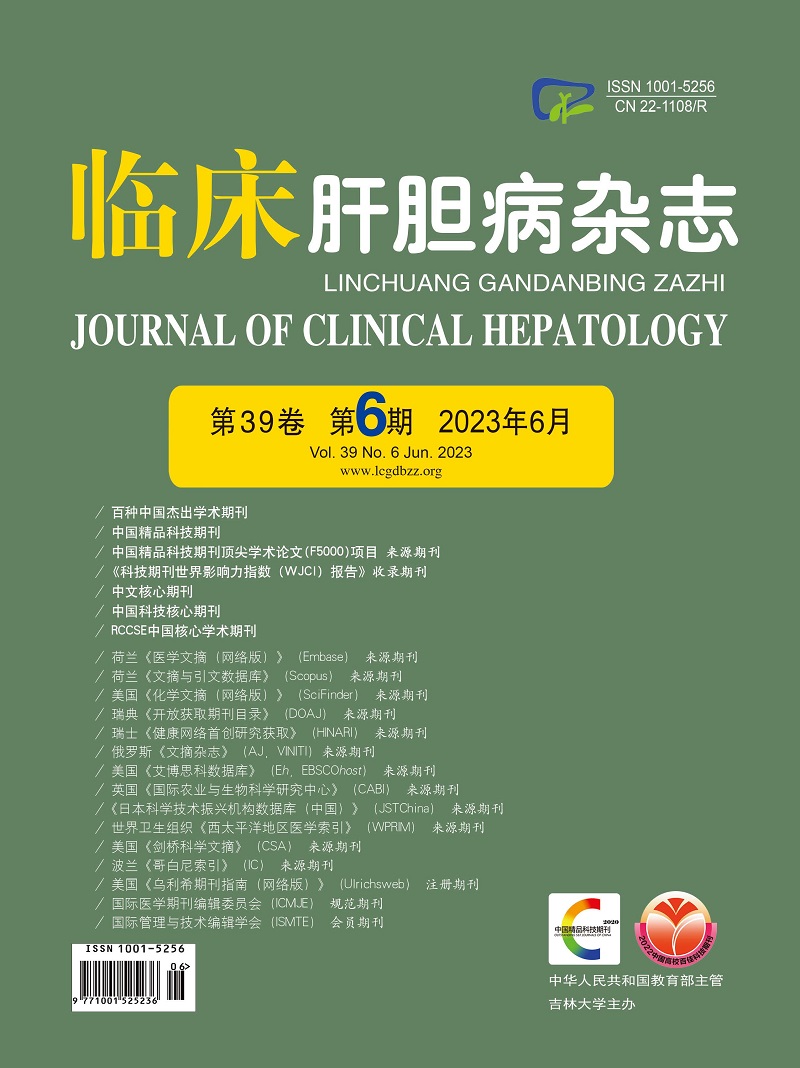| [1] |
MENG Z, CHEN Y, LU M. Advances in targeting the innate and adaptive immune systems to cure chronic hepatitis B virus infection[J]. Front Immunol, 2019, 10: 3127. DOI: 10.3389/fimmu.2019.03127. |
| [2] |
COX MA, NECHANITZKY R, MAK TW. Check point inhibitors as therapies for infectious diseases[J]. Curr Opin Immunol, 2017, 48: 61-67. DOI: 10.1016/j.coi.2017.07.016. |
| [3] |
WANG L, WANG K, ZOU ZQ. Crosstalk between innate and adaptive immunity in hepatitis B virus infection[J]. World J Hepatol, 2015, 7(30): 2980-2991. DOI: 10.4254/wjh.v7.i30.2980. |
| [4] |
HOPCRAFT SE, DAMANIA B. Tumour viruses and innate immunity[J]. Philos Trans R Soc Lond B Biol Sci, 2017, 372(1732): 20160267. DOI: 10.1098/rstb.2016.0267. |
| [5] |
ZHAO HJ, HU YF, HAN QJ, et al. Innate and adaptive immune escape mechanisms of hepatitis B virus[J]. World J Gastroenterol, 2022, 28(9): 881-896. DOI: 10.3748/wjg.v28.i9.881. |
| [6] |
WU J, HAN M, LI J, et al. Immunopathogenesis of HBV infection[J]. Adv Exp Med Biol, 2020, 1179: 71-107. DOI: 10.1007/978-981-13-9151-4_4. |
| [7] |
JIN X, YAN ZH, LU L, et al. Peripheral Immune cells exhaustion and functional impairment in patients with chronic hepatitis B[J]. Front Med (Lausanne), 2021, 8: 759292. DOI: 10.3389/fmed.2021.759292. |
| [8] |
BAUDI I, KAWASHIMA K, ISOGAWA M. HBV-specific CD8 + T-cell tolerance in the liver[J]. Front Immunol, 2021, 12: 721975. DOI: 10.3389/fimmu.2021.721975. |
| [9] |
FISICARO P, BARILI V, ROSSI M, et al. Pathogenetic mechanisms of T cell dysfunction in chronic HBV infection and related therapeutic approaches[J]. Front Immunol, 2020, 11: 849. DOI: 10.3389/fimmu.2020.00849. |
| [10] |
ROTTE A, SAHASRANAMAN S, BUDHA N. Targeting TIGIT for immunotherapy of cancer: update on clinical development[J]. Biomedicines, 2021, 9(9): 1277. DOI: 10.3390/biomedicines9091277. |
| [11] |
STANIETSKY N, ROVIS TL, GLASNER A, et al. Mouse TIGIT inhibits NK-cell cytotoxicity upon interaction with PVR[J]. Eur J Immunol, 2013, 43(8): 2138-2150. DOI: 10.1002/eji.201243072. |
| [12] |
JIN HS, PARK Y. Hitting the complexity of the TIGIT-CD96-CD112R-CD226 axis for next-generation cancer immunotherapy[J]. BMB Rep, 2021, 54(1): 2-11. DOI: 10.5483/BMBRep.2021.54.1.229. |
| [13] |
HUANG Z, QI G, MILLER JS, et al. CD226: An emerging role in immunologic diseases[J]. Front Cell Dev Biol, 2020, 8: 564. DOI: 10.3389/fcell.2020.00564. |
| [14] |
HARJUNPÄÄ H, GUILLEREY C. TIGIT as an emerging immune checkpoint[J]. Clin Exp Immunol, 2020, 200(2): 108-119. DOI: 10.1111/cei.13407. |
| [15] |
WANG J, HOU H, MAO L, et al. TIGIT signaling pathway regulates natural killer cell function in chronic hepatitis B virus infection[J]. Front Med (Lausanne), 2021, 8: 816474. DOI: 10.3389/fmed.2021.816474. |
| [16] |
WEI YY, FAN J, SHAN MX, et al. TIGIT marks exhausted T cells and serves as a target for immune restoration in patients with chronic HBV infection[J]. Am J Transl Res, 2022, 14(2): 942-954.
|
| [17] |
LIU C, XU L, XIA C, et al. Increased proportion of functional subpopulations in circulating regulatory T cells in patients with chronic hepatitis B[J]. Hepatol Res, 2020, 50(4): 439-452. DOI: 10.1111/hepr.13472. |
| [18] |
ZHANG W, SUN H, SUN R, et al. HBV immune tolerance of HBs-transgenic mice observed through parabiosis with WT mice[J]. Front Immunol, 2022, 13: 993246. DOI: 10.3389/fimmu.2022.993246. |
| [19] |
LOZANO E, DOMINGUEZ-VILLAR M, KUCHROO V, et al. The TIGIT/CD226 axis regulates human T cell function[J]. J Immunol, 2012, 188(8): 3869-3875. DOI: 10.4049/jimmunol.1103627. |
| [20] |
JIA L, GAO Y, HE Y, et al. HBV induced hepatocellular carcinoma and related potential immunotherapy[J]. Pharmacol Res, 2020, 159: 104992. DOI: 10.1016/j.phrs.2020.104992. |
| [21] |
WU Y, HAO X, WEI H, et al. Blockade of T-cell receptor with Ig and ITIM domains elicits potent antitumor immunity in naturally occurring HBV-related HCC in mice[J]. Hepatology, 2023, 77(3): 965-981. DOI: 10.1002/hep.32715. |
| [22] |
XU F, JIN T, ZHU Y, et al. Immune checkpoint therapy in liver cancer[J]. J Exp Clin Cancer Res, 2018, 37(1): 110. DOI: 10.1186/s13046-018-0777-4. |
| [23] |
LIU X, LI M, WANG X, et al. PD-1 + TIGIT + CD8 + T cells are associated with pathogenesis and progression of patients with hepatitis B virus-related hepatocellular carcinoma[J]. Cancer Immunol Immunother, 2019, 68(12): 2041-2054. DOI: 10.1007/s00262-019-02426-5. |
| [24] |
YU L, LIU X, WANG X, et al. TIGIT + TIM-3 + NK cells are correlated with NK cell exhaustion and disease progression in patients with hepatitis B virus-related hepatocellular carcinoma[J]. Oncoimmunology, 2021, 10(1): 1942673. DOI: 10.1080/2162402X.2021.1942673. |
| [25] |
BLAZKOVA J, HUITING ED, BODDAPATI AK, et al. Correlation between TIGIT expression on CD8 + T cells and higher cytotoxic capacity[J]. J Infect Dis, 2021, 224(9): 1599-1604. DOI: 10.1093/infdis/jiab155. |
| [26] |
DUAN X, LIU J, CUI J, et al. Expression of TIGIT/CD155 and correlations with clinical pathological features in human hepatocellular carcinoma[J]. Mol Med Rep, 2019, 20(4): 3773-3781. DOI: 10.3892/mmr.2019.10641. |
| [27] |
AMANCHA PK, HONG JJ, ROGERS K, et al. In vivo blockade of the programmed cell death-1 pathway using soluble recombinant PD-1-Fc enhances CD4 + and CD8 + T cell responses but has limited clinical benefit[J]. J Immunol, 2013, 191(12): 6060-6070. DOI: 10.4049/jimmunol.1302044. |
| [28] |
FERRANDO-MARTINEZ S, SNELL BENNETT A, LINO E, et al. Functional exhaustion of HBV-specific CD8 T cells impedes pD-L1 blockade efficacy in chronic HBV infection[J]. Front Immunol, 2021, 12: 648420. DOI: 10.3389/fimmu.2021.648420. |
| [29] |
CHEW GM, FUJITA T, WEBB GM, et al. TIGIT marks exhausted T cells, correlates with disease progression, and serves as a target for immune restoration in HIV and SIV infection[J]. PLoS Pathog, 2016, 12(1): e1005349. DOI: 10.1371/journal.ppat.1005349. |
| [30] |
GE Z, ZHOU G, CAMPOS CARRASCOSA L, et al. TIGIT and PD1 co-blockade restores ex vivo functions of human tumor-infiltrating CD8 + T cells in hepatocellular carcinoma[J]. Cell Mol Gastroenterol Hepatol, 2021, 12(2): 443-464. DOI: 10.1016/j.jcmgh.2021.03.003. |
| [31] |
ZONG L, PENG H, SUN C, et al. Breakdown of adaptive immunotolerance induces hepatocellular carcinoma in HBsAg-tg mice[J]. Nat Commun, 2019, 10(1): 221. DOI: 10.1038/s41467-018-08096-8. |















 DownLoad:
DownLoad: